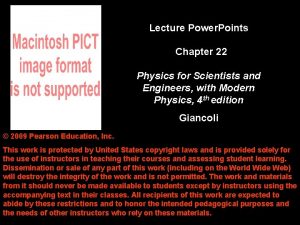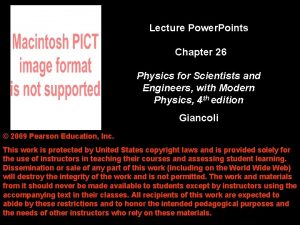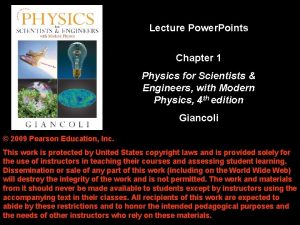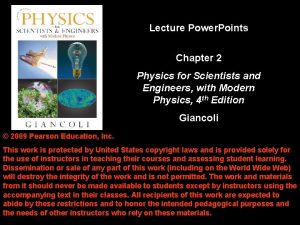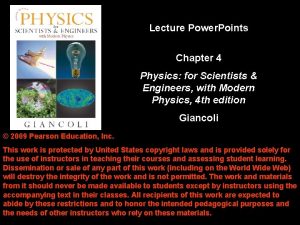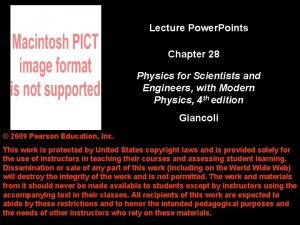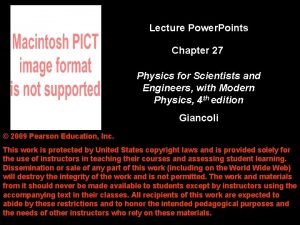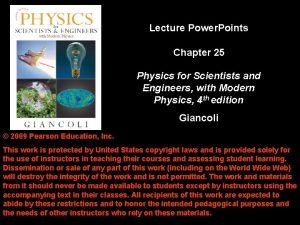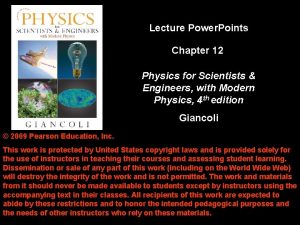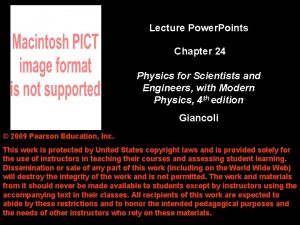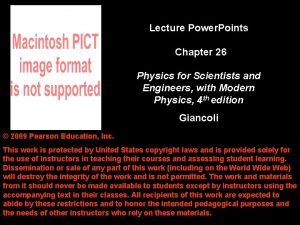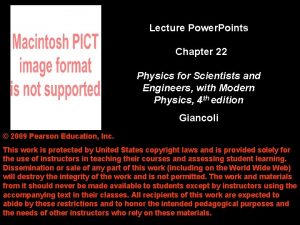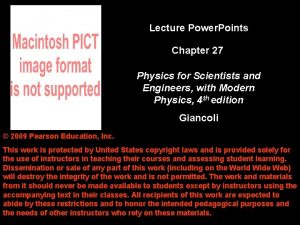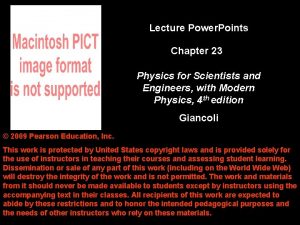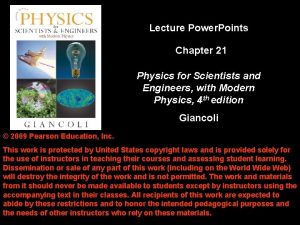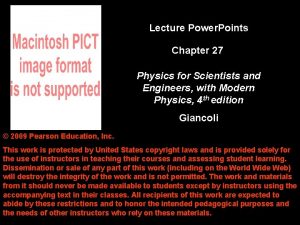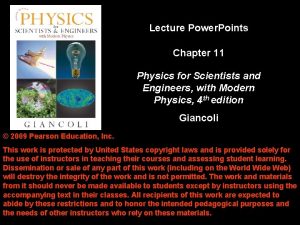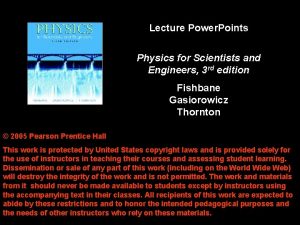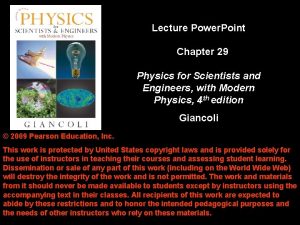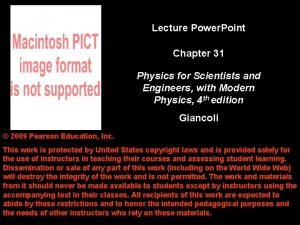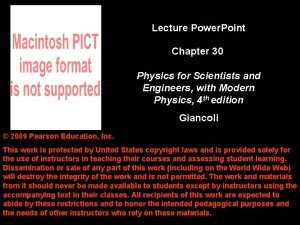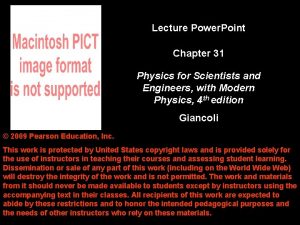Lecture Power Points Chapter 14 Physics for Scientists














































- Slides: 46

Lecture Power. Points Chapter 14 Physics for Scientists and Engineers, with Modern Physics, 4 th edition Giancoli © 2009 Pearson Education, Inc. This work is protected by United States copyright laws and is provided solely for the use of instructors in teaching their courses and assessing student learning. Dissemination or sale of any part of this work (including on the World Wide Web) will destroy the integrity of the work and is not permitted. The work and materials from it should never be made available to students except by instructors using the accompanying text in their classes. All recipients of this work are expected to abide by these restrictions and to honor the intended pedagogical purposes and the needs of other instructors who rely on these materials. Copyright © 2009 Pearson Education, Inc.

Chapter 14 Oscillations Copyright © 2009 Pearson Education, Inc.

Units of Chapter 14 • Oscillations of a Spring • Simple Harmonic Motion • Energy in the Simple Harmonic Oscillator • Simple Harmonic Motion Related to Uniform Circular Motion • The Simple Pendulum • The Physical Pendulum and the Torsion Pendulum • Damped Harmonic Motion • Forced Oscillations; Resonance Copyright © 2009 Pearson Education, Inc.

14 -1 Oscillations of a Spring If an object vibrates or oscillates back and forth over the same path, each cycle taking the same amount of time, the motion is called periodic. The mass and spring system is a useful model for a periodic system. Copyright © 2009 Pearson Education, Inc.

14 -1 Oscillations of a Spring We assume that the surface is frictionless. There is a point where the spring is neither stretched nor compressed; this is the equilibrium position. We measure displacement from that point (x = 0 on the previous figure). The force exerted by the spring depends on the displacement: Copyright © 2009 Pearson Education, Inc.

14 -1 Oscillations of a Spring • The minus sign on the force indicates that it is a restoring force—it is directed to restore the mass to its equilibrium position. • k is the spring constant. • The force is not constant, so the acceleration is not constant either. Copyright © 2009 Pearson Education, Inc.

14 -1 Oscillations of a Spring • Displacement is measured from the equilibrium point. • Amplitude is the maximum displacement. • A cycle is a full to-and-fro motion. • Period is the time required to complete one cycle. • Frequency is the number of cycles completed per second. Copyright © 2009 Pearson Education, Inc.

14 -1 Oscillations of a Spring If the spring is hung vertically, the only change is in the equilibrium position, which is at the point where the spring force equals the gravitational force. Copyright © 2009 Pearson Education, Inc.

14 -1 Oscillations of a Spring Example 14 -1: Car springs. When a family of four with a total mass of 200 kg step into their 1200 -kg car, the car’s springs compress 3. 0 cm. (a) What is the spring constant of the car’s springs, assuming they act as a single spring? (b) How far will the car lower if loaded with 300 kg rather than 200 kg? Copyright © 2009 Pearson Education, Inc.

14 -2 Simple Harmonic Motion Any vibrating system where the restoring force is proportional to the negative of the displacement is in simple harmonic motion (SHM), and is often called a simple harmonic oscillator (SHO). Substituting F = kx into Newton’s second law gives the equation of motion: with solutions of the form: Copyright © 2009 Pearson Education, Inc.

14 -2 Simple Harmonic Motion Substituting, we verify that this solution does indeed satisfy the equation of motion, with: The constants A and φ will be determined by initial conditions; A is the amplitude, and φ gives the phase of the motion at t = 0. Copyright © 2009 Pearson Education, Inc.

14 -2 Simple Harmonic Motion The velocity can be found by differentiating the displacement: These figures illustrate the effect of φ: Copyright © 2009 Pearson Education, Inc.

14 -2 Simple Harmonic Motion Because Copyright © 2009 Pearson Education, Inc. then

14 -2 Simple Harmonic Motion Example 14 -2: Car springs again. Determine the period and frequency of a car whose mass is 1400 kg and whose shock absorbers have a spring constant of 6. 5 x 104 N/m after hitting a bump. Assume the shock absorbers are poor, so the car really oscillates up and down. Copyright © 2009 Pearson Education, Inc.

14 -2 Simple Harmonic Motion The velocity and acceleration for simple harmonic motion can be found by differentiating the displacement: Copyright © 2009 Pearson Education, Inc.

14 -2 Simple Harmonic Motion Example 14 -3: A vibrating floor. A large motor in a factory causes the floor to vibrate at a frequency of 10 Hz. The amplitude of the floor’s motion near the motor is about 3. 0 mm. Estimate the maximum acceleration of the floor near the motor. Copyright © 2009 Pearson Education, Inc.

14 -2 Simple Harmonic Motion Example 14 -4: Loudspeaker. The cone of a loudspeaker oscillates in SHM at a frequency of 262 Hz (“middle C”). The amplitude at the center of the cone is A = 1. 5 x 10 -4 m, and at t = 0, x = A. (a) What equation describes the motion of the center of the cone? (b) What are the velocity and acceleration as a function of time? (c) What is the position of the cone at t = 1. 00 ms (= 1. 00 x 10 -3 s)? Copyright © 2009 Pearson Education, Inc.

14 -2 Simple Harmonic Motion Example 14 -5: Spring calculations. A spring stretches 0. 150 m when a 0. 300 -kg mass is gently attached to it. The spring is then set up horizontally with the 0. 300 -kg mass resting on a frictionless table. The mass is pushed so that the spring is compressed 0. 100 m from the equilibrium point, and released from rest. Determine: (a) the spring stiffness constant k and angular frequency ω; (b) the amplitude of the horizontal oscillation A; (c) the magnitude of the maximum velocity vmax; (d) the magnitude of the maximum acceleration amax of the mass; (e) the period T and frequency f; (f) the displacement x as a function of time; and (g) the velocity at t = 0. 150 s. Copyright © 2009 Pearson Education, Inc.

14 -2 Simple Harmonic Motion Example 14 -6: Spring is started with a push. Suppose the spring of Example 14– 5 (where ω = 8. 08 s-1) is compressed 0. 100 m from equilibrium (x 0 = -0. 100 m) but is given a shove to create a velocity in the +x direction of v 0 = 0. 400 m/s. Determine (a) the phase angle φ, (b) the amplitude A, and (c) the displacement x as a function of time, x(t). Copyright © 2009 Pearson Education, Inc.

14 -3 Energy in the Simple Harmonic Oscillator We already know that the potential energy of a spring is given by: The total mechanical energy is then: The total mechanical energy will be conserved, as we are assuming the system is frictionless. Copyright © 2009 Pearson Education, Inc.

14 -3 Energy in the Simple Harmonic Oscillator If the mass is at the limits of its motion, the energy is all potential. If the mass is at the equilibrium point, the energy is all kinetic. We know what the potential energy is at the turning points: Copyright © 2009 Pearson Education, Inc.

14 -3 Energy in the Simple Harmonic Oscillator The total energy is, therefore, And we can write: This can be solved for the velocity as a function of position: where Copyright © 2009 Pearson Education, Inc.

14 -3 Energy in the Simple Harmonic Oscillator This graph shows the potential energy function of a spring. The total energy is constant. Copyright © 2009 Pearson Education, Inc.

14 -3 Energy in the Simple Harmonic Oscillator Example 14 -7: Energy calculations. For the simple harmonic oscillation of Example 14– 5 (where k = 19. 6 N/m, A = 0. 100 m, x = (0. 100 m) cos 8. 08 t, and v = (0. 808 m/s) sin 8. 08 t), determine (a) the total energy, (b) the kinetic and potential energies as a function of time, (c) the velocity when the mass is 0. 050 m from equilibrium, (d) the kinetic and potential energies at half amplitude (x = ± A/2). Copyright © 2009 Pearson Education, Inc.

14 -3 Energy in the Simple Harmonic Oscillator Conceptual Example 14 -8: Doubling the amplitude. Suppose this spring is stretched twice as far (to x = 2 A). What happens to (a) the energy of the system, (b) the maximum velocity of the oscillating mass, (c) the maximum acceleration of the mass? Copyright © 2009 Pearson Education, Inc.

14 -4 Simple Harmonic Motion Related to Uniform Circular Motion If we look at the projection onto the x axis of an object moving in a circle of radius A at a constant speed υM , we find that the x component of its velocity varies as: This is identical to SHM. Copyright © 2009 Pearson Education, Inc.

14 -5 The Simple Pendulum A simple pendulum consists of a mass at the end of a lightweight cord. We assume that the cord does not stretch, and that its mass is negligible. Copyright © 2009 Pearson Education, Inc.

14 -5 The Simple Pendulum In order to be in SHM, the restoring force must be proportional to the negative of the displacement. Here we have: which is proportional to sin θ and not to θ itself. However, if the angle is small, sin θ ≈ θ. Copyright © 2009 Pearson Education, Inc.

14 -5 The Simple Pendulum Therefore, for small angles, we have: where The period and frequency are: Copyright © 2009 Pearson Education, Inc.

14 -5 The Simple Pendulum So, as long as the cord can be considered massless and the amplitude is small, the period does not depend on the mass. Copyright © 2009 Pearson Education, Inc.

14 -5 The Simple Pendulum Example 14 -9: Measuring g. A geologist uses a simple pendulum that has a length of 37. 10 cm and a frequency of 0. 8190 Hz at a particular location on the Earth. What is the acceleration of gravity at this location? Copyright © 2009 Pearson Education, Inc.

14 -6 The Physical Pendulum and the Torsional Pendulum A physical pendulum is any real extended object that oscillates back and forth. The torque about point O is: Substituting into Newton’s second law gives: Copyright © 2009 Pearson Education, Inc.

14 -6 The Physical Pendulum and the Torsional Pendulum For small angles, this becomes: which is the equation for SHM, with Copyright © 2009 Pearson Education, Inc.

14 -6 The Physical Pendulum and the Torsional Pendulum Example 14 -10: Moment of inertia measurement. An easy way to measure the moment of inertia of an object about any axis is to measure the period of oscillation about that axis. (a) Suppose a nonuniform 1. 0 -kg stick can be balanced at a point 42 cm from one end. If it is pivoted about that end, it oscillates with a period of 1. 6 s. What is its moment of inertia about this end? (b) What is its moment of inertia about an axis perpendicular to the stick through its center of mass? Copyright © 2009 Pearson Education, Inc.

14 -6 The Physical Pendulum and the Torsional Pendulum A torsional pendulum is one that twists rather than swings. The motion is SHM as long as the wire obeys Hooke’s law, with (K is a constant that depends on the wire. ) Copyright © 2009 Pearson Education, Inc.

14 -7 Damped Harmonic Motion Damped harmonic motion is harmonic motion with a frictional or drag force. If the damping is small, we can treat it as an “envelope” that modifies the undamped oscillation. If then Copyright © 2009 Pearson Education, Inc.

14 -7 Damped Harmonic Motion This gives If b is small, a solution of the form will work, with Copyright © 2009 Pearson Education, Inc.

14 -7 Damped Harmonic Motion If b 2 > 4 mk, ω’ becomes imaginary, and the system is overdamped (C). For b 2 = 4 mk, the system is critically damped (B) —this is the case in which the system reaches equilibrium in the shortest time. Copyright © 2009 Pearson Education, Inc.

14 -7 Damped Harmonic Motion There are systems in which damping is unwanted, such as clocks and watches. Then there are systems in which it is wanted, and often needs to be as close to critical damping as possible, such as automobile shock absorbers and earthquake protection for buildings. Copyright © 2009 Pearson Education, Inc.

14 -7 Damped Harmonic Motion Example 14 -11: Simple pendulum with damping. A simple pendulum has a length of 1. 0 m. It is set swinging with small-amplitude oscillations. After 5. 0 minutes, the amplitude is only 50% of what it was initially. (a) What is the value of γ for the motion? (b) By what factor does the frequency, f’, differ from f, the undamped frequency? Copyright © 2009 Pearson Education, Inc.

14 -8 Forced Oscillations; Resonance Forced vibrations occur when there is a periodic driving force. This force may or may not have the same period as the natural frequency of the system. If the frequency is the same as the natural frequency, the amplitude can become quite large. This is called resonance. Copyright © 2009 Pearson Education, Inc.

14 -8 Forced Oscillations; Resonance The sharpness of the resonant peak depends on the damping. If the damping is small (A) it can be quite sharp; if the damping is larger (B) it is less sharp. Like damping, resonance can be wanted or unwanted. Musical instruments and TV/radio receivers depend on it. Copyright © 2009 Pearson Education, Inc.

14 -8 Forced Oscillations; Resonance The equation of motion for a forced oscillator is: The solution is: where and Copyright © 2009 Pearson Education, Inc.

14 -8 Forced Oscillations; Resonance The width of the resonant peak can be characterized by the Q factor: Copyright © 2009 Pearson Education, Inc.

Summary of Chapter 14 • For SHM, the restoring force is proportional to the displacement. • The period is the time required for one cycle, and the frequency is the number of cycles per second. • Period for a mass on a spring: • SHM is sinusoidal. • During SHM, the total energy is continually changing from kinetic to potential and back. Copyright © 2009 Pearson Education, Inc.

Summary of Chapter 14 • A simple pendulum approximates SHM if its amplitude is not large. Its period in that case is: • When friction is present, the motion is damped. • If an oscillating force is applied to a SHO, its amplitude depends on how close to the natural frequency the driving frequency is. If it is close, the amplitude becomes quite large. This is called resonance. Copyright © 2009 Pearson Education, Inc.
 01:640:244 lecture notes - lecture 15: plat, idah, farad
01:640:244 lecture notes - lecture 15: plat, idah, farad Power triangle diagram
Power triangle diagram Points of parity and points of difference
Points of parity and points of difference Points of parity and points of difference
Points of parity and points of difference Physics 111 lecture notes
Physics 111 lecture notes What is a harmonic wave in physics
What is a harmonic wave in physics Physics 101 lecture 1
Physics 101 lecture 1 Physics 101 lecture notes pdf
Physics 101 lecture notes pdf Wave notes pdf
Wave notes pdf Atmospheric physics lecture notes
Atmospheric physics lecture notes Power system dynamics and stability lecture notes
Power system dynamics and stability lecture notes Zline 667-36
Zline 667-36 Power semiconductor devices lecture notes
Power semiconductor devices lecture notes Switch mode power supply lecture notes
Switch mode power supply lecture notes Power system dynamics and stability lecture notes
Power system dynamics and stability lecture notes Prayer for authority and power
Prayer for authority and power Why does it happen
Why does it happen University physics with modern physics fifteenth edition
University physics with modern physics fifteenth edition Ib physics ia ideas thermal physics
Ib physics ia ideas thermal physics Fspos
Fspos Novell typiska drag
Novell typiska drag Nationell inriktning för artificiell intelligens
Nationell inriktning för artificiell intelligens Ekologiskt fotavtryck
Ekologiskt fotavtryck Varför kallas perioden 1918-1939 för mellankrigstiden
Varför kallas perioden 1918-1939 för mellankrigstiden En lathund för arbete med kontinuitetshantering
En lathund för arbete med kontinuitetshantering Kassaregister ideell förening
Kassaregister ideell förening Tidböcker
Tidböcker Anatomi organ reproduksi
Anatomi organ reproduksi Densitet vatten
Densitet vatten Datorkunskap för nybörjare
Datorkunskap för nybörjare Boverket ka
Boverket ka Hur skriver man en debattartikel
Hur skriver man en debattartikel Delegerande ledarskap
Delegerande ledarskap Nyckelkompetenser för livslångt lärande
Nyckelkompetenser för livslångt lärande Påbyggnader för flakfordon
Påbyggnader för flakfordon Kraft per area
Kraft per area Svenskt ramverk för digital samverkan
Svenskt ramverk för digital samverkan Jag har nigit för nymånens skära
Jag har nigit för nymånens skära Presentera för publik crossboss
Presentera för publik crossboss Argument för teckenspråk som minoritetsspråk
Argument för teckenspråk som minoritetsspråk Bat mitza
Bat mitza Klassificeringsstruktur för kommunala verksamheter
Klassificeringsstruktur för kommunala verksamheter Luftstrupen för medicinare
Luftstrupen för medicinare Claes martinsson
Claes martinsson Centrum för kunskap och säkerhet
Centrum för kunskap och säkerhet Verifikationsplan
Verifikationsplan Mat för idrottare
Mat för idrottare















































